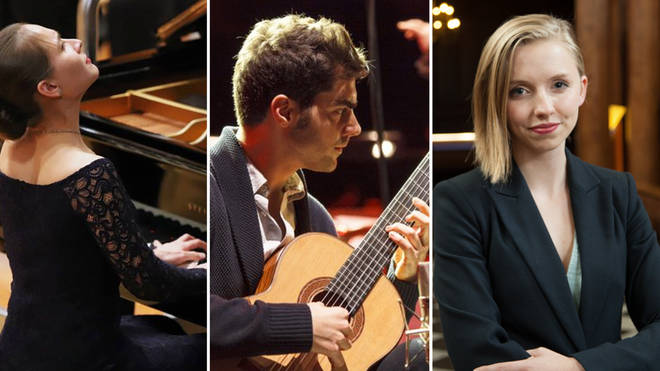But as always – there’s more to the story of Beethoven’s famous Symphony in C Minor, No. 5.
About the composition
Despite the work’s formal title, its famous opening doesn’t reach a true C minor until the third repetition of the four notes. While the symphony does quickly get to C minor, it concludes in a hearty C-major coda. You can hear a lighter, more festive version of the opening of the first movement played in C-major here.
Beethoven was already growing deaf when he started his fifth symphony in 1804. He began working on it short after finishing his third symphony. Even so, he was working on so many other works at the time, it took him four years to complete it. It wasn’t just the other projects; he was also a notorious editor of his work. The fifth symphony is one the apex symphonies of his Heroic Period (1803 – 1815), during which he composed this third through eighth symphonies, and broke from classical structures and introduced the Romantic era.
Yet the symphony does follow the classical symphonic structure of four movements. The first movement is defined by the opening four notes. Beethoven’s secretary wrote, after the composer’s death, that Beethoven had described this motif and the foundational idea of the entire work as “fate knocking at the door!” This story held for so long, the opening is also called the “Fate motif.”
Alas, his secretary has been found to be an unreliable memoirist who looked back at Beethoven through perhaps too rosy a pair of glasses. Some have suggested Beethoven’s inspiration for this opening motif is the sound of the Yellowhammer birds that lived in the parks in Vienna. Others still say the opening fits the more martial temperament of his Heroic Period that reflects the revolutionary state of Europe at the time.
The fourth movement provides some support to this last idea. It’s an explosion of sound that quotes from a composition by French Revolutionary War army officer, Claude Joseph Rouget de Lisle, who also wrote the music and lyrics to what would become France’s national anthem, La Marseillaise.
About its performances
Symphony No. 5 in C minor debuted in Vienna on December 22, 1808 at the Theater an der Wien. This concert was Beethoven’s famous marathon concert, running four hours long under horrible conditions. The program was all Beethoven, and the badly rehearsed orchestra was conducted by Beethoven. The Sixth Symphony also made its debut at this concert and was in fact played before the Fifth as the numbers of each symphony were reversed in the program.
The entire concert, including these premieres, was considered a failure due to a combination of not very talented musicians performing in a cold hall in December. One attendee who wanted to leave mid-performance, explained why the audience remained for the entire four hours, “Beethoven was in the middle of conducting and was close at hand.”
Despite its inauspicious beginnings, it quickly gained popular and critical acclaim. It was performed at the inaugural concerts for the New York Philharmonic (December 7, 1842) and the National Symphony Orchestra (November 2, 1931), as well as during the inaugural week of Carnegie Hall (May 9, 1891). It remains a favorite choice for inaugurating new orchestras or music halls.
The romantic symphony also made disco history with A Fifth of Beethoven, which was a number 1 hit from the famous disco-era film Saturday Night Fever. You can also find rock, salsa and a mashup with Mambo No. 5 versions.
The 5th through history
Critic E.T.A. Hoffmann is credited with establishing the symphony’s reputation. He published a detailed and highly complementary critique of the work in 1813, which he called the symphony a “rhapsody of genius” and “a work that is splendid beyond all measure.” Hector Berlioz likened the third movement to “the gaze of a mesmerizer.” Sir John Eliot Gardiner described the four-note Fate motif as “an alarm call, an incitement, a call to arms,” as it was composed in the context of revolution sweeping Europe. Donald Francis Tovey called it "among the least misunderstood of musical classics."
The opening four notes were a crucial and (shall we say) instrumental part of Europeans’ passive resistance to Nazi tyranny during World War II. The “V for Victory” campaign began in Belgium as a call for people to write the letter “V” as a sign of resistance. Winston Churchill promoted the campaign and integrated making the fingers raised in a V-sign. The next day, BBC radio encouraged listeners in Paris to stage a "quiet knocking" demonstration, using The Fifth Symphony’s four notes, as the roman numeral for the five is “V.”
Soon, the BBC, which broadcast into Nazi-occupied countries, began using the four notes as its station identification call sign. BBC radio programs also instructed people throughout Europe how they could play the same four notes themselves, teachers on blackboard, trains tooting it out through their steam engines, and children clapping their hands. For this reason, the symphony has also been known as the Victory Symphony since World War II.
Lastly, the work was included on the Golden Disc launched into space in 1977 on the Voyager spacecraft. The disc on the spacecraft, perpetually spinning through space, is filled with audio and image files intended to display the creativity and diversity of life on Earth to any extra-terrestrial that might come across it. Here is the first movement recording on the Golden Disc.
This article sponsored by Thomastik-Infeld










